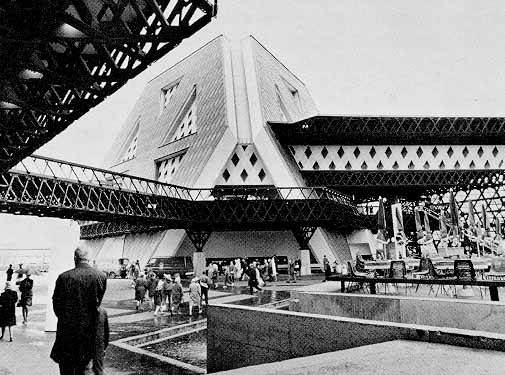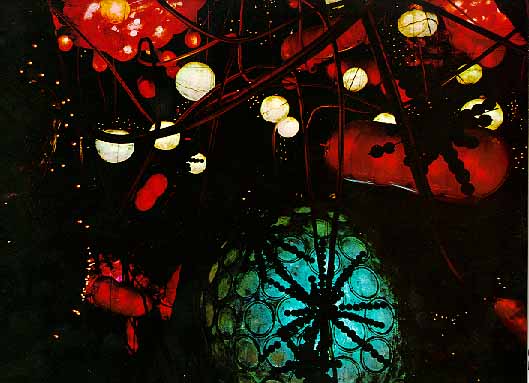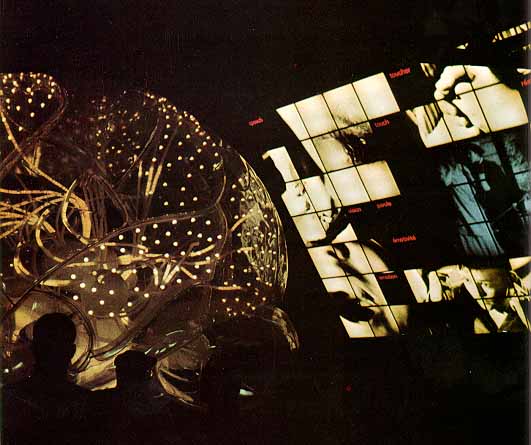Man the Explorer
The Man the Explorer complex contains four exhibit areas in three interconnected buildings around a plaza. These include Man and Life (south building), Man, his Planet & Space (northeast building), Man and the Oceans (northwest building - upper level), Man and the Polar Regions (northwest building - lower level).
| One of the buildings in the Man the Explorer complex. |
A human cell, magnified one million times, greeted the visitor in the Man and Life pavilion. Further on an enormous human brain, electronically controlled, explained the evolution of reflex actions, using networks of lights to show how the brain receives external stimuli and orders an appropriate response.
 |
A walk-thru human cell magnified one million times. |
In another hall, the world of the child and the world of the adult were placed side by side. A display allows children to perform an experiment where water, when poured from one vessel to that of a different shape, doesn't change volume. While it was obvious to an adult, children younger than seven can't grasp the fact. Other experiments show that adults, too, can be victims of illusion and ignorance. The message implied is that progress in science is a matter of trial and error and that many amazing discoveries are the result of chance or some fortunate mistake.
 |
A large model of the human brain. |
The visitor to Man, His Planet and Space was met by huge photographs of the Earth that revealed unusual aspects of our planet. There in the first hall was a huge vertical screen in three sections where three different films were presented that showed parallel problems in different regions of the globe. They depicted man's careless destruction of nature's irreplaceable resources.
In another hall showed the means man has invented for exploring the regions under the Earth's surface and for tapping its resources. The visitor walked through an illuminated model of the Earth, and when he came up to the surface, he was presented with the crucial importance of the population explosion - ever changing figures on a chart showed the world's increase in people; 130 per minute.
The final exhibits traced man's early attempts to reach space. The exhibit went from man's earliest attempts to imitate birds, to in less than 50 years the reality of the supersonic jet to the feats of the first men in space.
Man and the Polar Regions appears to be a cave hewn out of ice as the visitor was met by gusts of cold air. Log-books and other documents of polar explorers Amundsen, Scott and Byrd were displayed. Nearby, two small globes opened periodically to reveal the main differences between the Arctic and Antarctic.
Another part of the pavilion was devoted to the inhabitants of the polar regions. Exhibits and photographs offered a glimpse of the Eskimos of Greenland, the Lapps of Scandinavia, the Yakuts and Samoyeds of Siberia. And in the last hall, eleven synchronized projectors on three screens showed scenes of the polar regions. The theater was unique in that it was circular and rotated so that it moved viewers from one set of screens to the next.
 |
Minirail and pedestrians pass the Man the Explorer complex on the left. Photo by Bill Dutfield. |
In the Man and the Oceans pavilion sound and light combined to create the impressions of waves. A foot bridge of transparent glass offered a view of old anchors and shells. An escalator lead up to a gallery over a large tank where visitors watched diving demonstrations. On display were Saucer SP300 and Saucer SP4000, inventions of Commander Jacques Yves Cousteau for underwater exploration.
Another display chronicled navigation and the progressive transformation of primitive sailing ships into modern ships. Shown were radar equipment, the automatic pilot, the meteorological buoy, and the communications satellite. And the final exhibit, in the form of large glass tubes arranged like stalactites and stalagmites, displayed many of the products man has learned to extract from the sea.
